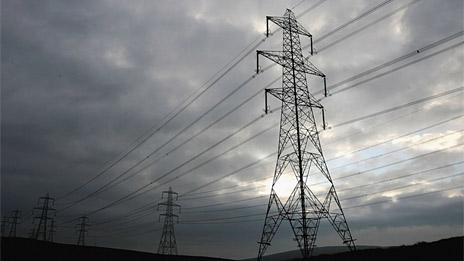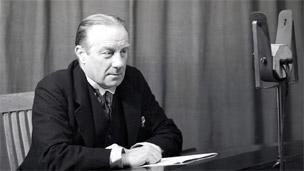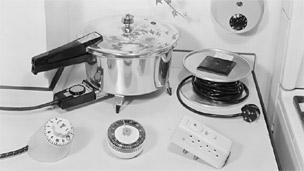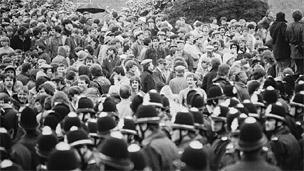The Secret Life of the National Grid
- Published

Electricity pylons first appeared on Britain's skyline in the 1920s
Ever since Prime Minster Stanley Baldwin promised a land of cheap and abundant electricity in 1926, we have grown ever more dependent on free-flowing power.
It has become as essential to the modern world as water and sunlight were to previous ages.
But with concern over climate change and Britain's nuclear power stations coming to the end of their useful life that era may be rapidly coming to an end.
With Britain at an energy crossroads, a new BBC Four series, the Secret Life of the National Grid, tells the story of how the grid has shaped not only British politics but our landscape and our lives.
WIRING THE NATION
Before the National Grid was set up, electricity was generated and supplied by a hotch-potch of private companies and municipal councils.
In Britain's laissez-faire environment a huge range of systems were in operation, and, for many, electricity was prohibitively expensive.

Stanley Baldwin is the father of the national grid
Keeping just five bulbs going for a day would cost a week's wages for the average person - and in 1920 only 6% of British homes were connected.
By contrast France and Germany, with their interventionist states, were using almost twice as much electricity as we were.
It put pipe-smoking Conservative PM Stanley Baldwin in a quandary - he didn't want to promote nationalisation, but at the same time it was clear that electricity was too expensive not just for consumers but for industrialists.
Baldwin's solution was the 1926 Electricity Supply Act, establishing a National Grid to connect the 122 most efficient power stations in the country.
Initiated by the state but ultimately run by one of the very first public corporations, the Central Electricity Board, the Grid was a prime example of a very British compromise. Pretty socialist but certainly not expressed as such.
Constructing it was no mean feat - 4,000 miles of transmission line and cable had to stretch across Britain.
Economics meant the vast majority of it would be carried by pylons. But sending steel giants to march across the British countryside was not undertaken lightly.
Classical architect Sir Reginald Blomfield was brought in to soften their appearance, and produced a design inspired by the architecture of ancient Egypt.
Not everyone was convinced: The advancing gangs of pylons inspired vociferous protests in Britain's beauty spots, and the objections then are echoed today in disputes over the Beauly Denny line, the £350m project to upgrade transmission between Inverness and Falkirk, which was the subject of the biggest planning inquiry ever held in Scotland.
Nevertheless, the grid had its desired effect: by the start of the Second World War two thirds of homes were connected. It was the beginning of a system that linked the British together more intimately than ever before.
SWITCHING ON
The first switch flicked by most homes was the light switch.
Engineer Hector MacLean remembers the instant response of his parents to the brightness was "Cor, look at the dust, we need to repaint".

The British were encouraged to buy electrical appliances
But by the mid 1950s over half of consumers had sockets too and the biggest driver for fitting plug points had been the electric iron.
For the Grid though, steep peaks in electricity usage in the mornings and evenings from electric light, and on washdays from irons, wasn't an efficient use of the system.
It's a capital intensive industry, and once the power stations and transmission lines were built, from the Grid's perspective it made economic sense to turn them to as much use as possible. It wanted to fill in the troughs in demand during the day, and ideally during the night as well.
So electricity boards went on the offensive and actively promoted electrical appliances - particularly high current ones such as cookers and immersion heaters. Electricity showrooms became a fixture on high streets to entice the British to use electricity in their homes.
But the grid didn't just mean gadgets. Its biggest customer was the sector that had campaigned hardest for it in the first place - industry.
In the post war period up until the early 1970s, manufacturing accounted for almost 40% of Britain's gross domestic product, and much of it was on electrically-driven production lines.
Mass manufacture was and is dependent on electricity and the post-war boom was driven by a virtuous circle of falling prices and rising wages. It transformed living standards for many and laid the foundations for our consumer society.
Today we're electricity junkies. There are few parts of our lives that aren't plugged in to the grid - whether it's at work in offices full of computers, elevators and air-conditioning; or in our leisure time with ipods, TVs and even electrically powered gyms (Well, we have to make up for all those labour saving devices somewhere). But the only time we notice it is when there is a power cut.
PULLING THE PLUG
As Britain has become increasingly dependent on a centralised electricity system it has made us vulnerable to whoever has the power to pull the plug. Our first taste came in December 1970.
Electricity supply workers began an overtime ban and working to rule. Their union thought it would take three weeks to a month before there was a serious break down in the supply of electricity. In fact it took just 8 hours.

The lights stayed on during the 1984 miners strike
In a chaotic week of power cuts, the army was mobilized to send emergency generators to hospitals. Bouts of shop-lifting erupted in darkened department stores and the country was brought to a standstill. T
The public was outraged and the electricity workers chastened - in seven days they were at the negotiating table and the lights were back on.
But the power of pulling the plug had been there for all to see. We depended on electricity, and three quarters of Britain's power stations relied on one fuel - coal.
The scene was set for the miners' disputes and power cuts of the 1970s that culminated in the three day week and Edward Heath's election defeat in 1974. It was a bitter lesson for politicians, particularly the Conservatives: fail to keep the lights on at your own peril. But the victory would ultimately haunt the miners when Margaret Thatcher was in power in the 1980s.
Today coal (most of it imported) generates just 28% of Britain's electricity. For decades it was nuclear that aspired to take its place, and Britain had the first commercial nuclear power station in the world in 1956 with Calder Hall. But our dogged technological nationalism came with a hefty price tag and even today the cost remains high.
Instead, in the privatised electricity industry, it was cheap North Sea gas that took King Coal's crown.
Gas now generates 45% of our power, but with national reserves dwindling, there are increasing concerns over energy security. In Britain we are blessed with some of the best wind reserves in Europe, but how much of the gap can renewables really fill?
Almost 85 years on from Baldwin's initial promise, we're having to consider for the first time the merits of switching off, and just what price we're ultimately prepared to pay to keep on powering our electric dreams.
The Secret Life of the National Grid starts on Tuesday, 26 October at 9pm on BBC Four and continues on the 2nd and 9th of November.